Leeds
Explore hidden histories, historic photos, and things you never knew about Leeds from the collections and archives of Historic England.
Discover your local listed buildings and places
Introducing some of Leeds' most historic sites, included in the National Heritage List for England. Some of these captions have been summarised by AI. Click through for the official List entry. Skip this section and go to place by numbers
Armley House (Gott's Park)
Leeds
Armley House (Gott's Park), developed in the late 18th century, was influenced by Thomas White and partially redesigned by Humphry Repton for Benjamin Gott.
Ledston Hall and Park
Ledsham
Ledston Hall and Park has a rich history starting from the 11th century. It features gardens designed by Charles Bridgeman and alterations by Lady Elizabeth Hastings in the 18th century.
E.c. Stoner Building, Computer Science Building, Mathemat…
Leeds
University Campus buildings, comprising E C Stoner Building (physics), Mathematics, Earth Sciences, Computer Studies, Senior Common Room, Garstang Building, Manton Building, Communications...
Harewood House
Harewood
Country House. 1759-71, the central part of the house by John Carr, the two lateral extensions and wings by Robert Adam (Swarbrick, p. 194).
Dalton Parlours Roman villa and Iron Age settlement
Collingham
Dalton Parlours Roman villa was a high-status estate with agricultural and military ties, featuring extensive buildings and structures.
Light Anti-Aircraft gun emplacement for the former Thorp …
Walton
Second World War Light Anti-Aircraft gun emplacement, circa 1941.
Adel Roman fort and settlement
Alwoodley
Buried archaeological remains of a Roman fort established in the late 1st century, along with an associated vicus (civilian settlement) that continued into at least the 4th century.
Micklefield House
Rawdon
Large detached villa, now council offices, 1847, by John Tertius Fairbank, with a large extension of 1872 and further later additions and alterations.
Former World War I National Filling Factory, Barnbow
Barwick in Elmet and Scholes
Former First World War National Filling Factory surviving as standing, buried and earthwork remains.
Howley Hall; a 16th century country house and gardens
Morley
Howley Hall, a 16th-century Elizabethan country house, exemplifies late Tudor and early Jacobean architecture, reflecting historical artistic and architectural development unique to England.
Harewood House
Alwoodley
Harewood House was designed by John Carr, with gardens and parkland developed by notable figures including Lancelot Brown and Humphry Repton. It remains privately owned.
Railway viaduct MDL1/40, Churwell Viaduct
Morley
Viaduct carrying the Leeds, Dewsbury & Manchester Railway, mid-1840s, by Thomas Grainger.
Lawnswood Cemetery
Leeds
A cemetery designed by the Leeds architect, George Corson, assisted by the landscape gardener, William Gay of Bradford, opened in 1875.
Adel Reformatory
Leeds
Reform school, approved school, community home (now disused), 1857 with later C19 and C20 additions, by William Watson Hewitson of Kitson & Hewitson, for Leeds Society for the Reformation of...
Templar Hotel, including 6 Templar Street
Leeds
Public house, early C19, extended in the mid-late C19 and subsequently altered and remodelled in 1928 to designs by Garside and Pennington of Pontefract for Melbourne Brewery (Leeds) Ltd,...
Bank House
Leeds
Former Bank of England regional headquarters building, 1969-71, by Building Design Partnership.
Temple Newsam
Leeds
Parkland with late-C17 elements and an early-C18 approach with a bridge and ponds by William Etty, remodelled during the 1760s to a partially executed scheme by Lancelot 'Capability' Brown.
Former Drighlington Junior School
Drighlington
Former board school, 1874-75, by Lockwood & Mawson, coursed sandstone with ashlar dressings, slate roofs, single-storey, classical detailing.
18-26 King Edward Street and 49-51 Vicar Lane, Leeds
Leeds
Block of shops, offices and former restaurant, 1898-1904, altered in the C20. By Frank Matcham for the Leeds Estates Company as part of the County Arcade development. Free Baroque style.
'A Celebration of Engineering Sciences' relief mural, Dep…
Leeds
Sculptural relief. 1963, designed by Allan Johnson, fabricated by Alec Dearnley. Glass fibre reinforced polyester (GFRP).
Crawshaw Woods (Shippen House Farm) bridge, HUL4/20
Leeds
Railway cast-iron overbridge. c1830-34 by James Walker of Walker & Burges for Leeds & Selby Railway. Contractor Stanningley Ironworks.
Stone hut circle settlement in Clayton Wood on the south …
Leeds
Stone hut circles at Clayton Wood are key prehistoric farm settlements, mostly from the Bronze Age, representing social and farming practices in early communities.
Henry Price Residence
Leeds
University hall of residence, 1964, by Chamberlin, Powell and Bon with structural engineers Flint and Neill: Christof Bon was the lead architect for this building.
High Royds Hospital
Menston
High Royds Hospital, initially named Menston Mental Hospital, was designed in 1884 by Vickers Edwards. It served Leeds and Bradford's growing population and accommodated 1600 patients.
Lotherton Hall
Lotherton cum Aberford
Lotherton Hall, originally from the 18th century, is noted for its gardens designed by Laura Gascoigne with advice from Ellen Willmott (1902-20), featuring formal and picturesque elements.
Church of St John
Leeds
Church of St John the Evangelist, 1632-1634, founded by John Harrison with C19 alterations by Norman Shaw, Temple Moore and other locally notable architects.
Pudsey Cemetery
Pudsey
A public cemetery opened in 1875, with both layout and buildings designed by William Gay.
Former Office of the West Yorkshire Archives Service
Leeds
A former branch library of 1939, later an archive office, unused at the time of inspection (2012).
Grand Arcade
Leeds
Shopping arcade, between 1897 and 1898, by Smith and Tweedale for Francis Lupton of New Briggate Arcade Limited, with C20 and C21 alterations.
Kirkstall Abbey and precinct including a prehistoric cup …
Leeds
Kirkstall Abbey, founded by Cistercian monks in 1152, is a well-preserved example of medieval monastic life, notable for its architecture and historical documentation.
Roundhay Park
Leeds
Roundhay Park, in Leeds, features 19th-century parkland with lakes, pleasure grounds, and municipal gardens. Originally a deer park, it became public after purchase by Leeds City Council.
Austhorpe Lane Bridge, HUL4/21
Leeds
Railway basket arch overbridge, c1830-34 by James Walker of Walker & Burges for Leeds & Selby Railway.
Original Infirmary and Corson's Pavilion Wing
Leeds
Hospital including chapel. 1864 to 1868 by George Gilbert Scott (1811-1878, knighted 1872). Pavilion ward block, 1889 to 1892 by George Corson.
Railway underbridge MDL1/35, Howley Mill Lane
Morley
Railway underbridge for the Leeds, Dewsbury & Manchester Railway line. Mid-1840s, by Thomas Grainger. Sandstone.
Fairburn Ings (Newton Abbey) moat
Ledsham
Fairburn Ings moat is a medieval status symbol rather than a defense structure, with preserved organic remains suggesting aristocratic heritage from between 1250-1350.
Burley Branch Library, including front railings
Leeds
Former library, now disused, 1926, by Gilbert Burdett Howcroft. Mellow red brick with Portland stone and sandstone dressings, single-storey plus basement. Neo-Georgian style.
Brady Farm Bridge, HUL4/15
Sturton Grange
Railway basket-arch overbridge, constructed for the Leeds & Selby Railway in 1832-3 to the designs of Walker & Burges; the contractors were Hamer & Pratt.
Explore more
Search for more listed placesLeeds through time
This timeline shows the first period of use for buildings and places on the National Heritage List for England, just one of the details recorded for every list entry. Click around to see how Leeds changes over time. Skip this section and go to aerial photos
Prehistoric Before AD 43
Prehistory covers a million years of human occupation before the Roman invasion, from hunter-gatherers of several human species, including Neanderthals, to more recent herders and farmers. It was a time of developing technologies and belief systems, involving contact with and migration from Europe, all reflected in the variety of artefact and monument types characteristic of particular prehistoric periods.
Roman AD 43 to AD 410
Britain was invaded by four legions of the Roman army in AD 43, who relatively rapidly conquered England from landing points in Kent. Parts of Wales and Scotland soon followed.
Roman culture brought urbanism, monumental buildings, wide-ranging religious beliefs, writing, and strong social hierarchy. The Roman administrative system was withdrawn in AD 410.
Early medieval AD 410 to AD 1066
This period, often associated in England with Anglo-Saxons and Vikings, saw a reduction in urban living from the Roman period and increased migration from northern Europe.
Traces of this period can be found in cemeteries, particularly in artefacts and in some of the very early churches, as this period also saw the growth of Christianity in Britain.
Medieval AD 1066 to AD 1540
This period, sometimes known as the Middle Ages, began with the Norman invasion in AD 1066. It saw a significant rise in military and defensive buildings such as castles and earthworks, as well as religious houses dominating a largely agricultural landscape.
The monarchy and Church dominated the period, which also saw the break with the Roman Catholic Church and the English reformation.
Post medieval AD 1540 to AD 1901
The Post-Medieval period brought seismic changes to life in England, with religious reformation leading to the democratization of worship and the destruction of hundreds of religious houses.
In parallel, there was a huge expansion of scientific study and enlightenment that permanently altered the nation's social structure and landscape. Industrialization and mass production lead to wider global trade, emigration, and immigration.
20th century AD 1901 to AD 2000
The 20th century saw an incredible expansion of England's transport networks, with suburban growth shadowing rapid infrastructural expansion. The establishment of state schools, hospitals, and modern technical colleges, with new architectural styles, radically changed the appearance of towns and cities.
Two catastrophic world wars and the 1918 pandemic also brought unprecedented change, altering England's built environment and social structures forever.
Prehistoric Before AD 43
Prehistory covers a million years of human occupation before the Roman invasion, from hunter-gatherers of several human species, including Neanderthals, to more recent herders and farmers. It was a time of developing technologies and belief systems, involving contact with and migration from Europe, all reflected in the variety of artefact and monument types characteristic of particular prehistoric periods.
Roman AD 43 to AD 410
Britain was invaded by four legions of the Roman army in AD 43, who relatively rapidly conquered England from landing points in Kent. Parts of Wales and Scotland soon followed.
Roman culture brought urbanism, monumental buildings, wide-ranging religious beliefs, writing, and strong social hierarchy. The Roman administrative system was withdrawn in AD 410.
Early medieval AD 410 to AD 1066
This period, often associated in England with Anglo-Saxons and Vikings, saw a reduction in urban living from the Roman period and increased migration from northern Europe.
Traces of this period can be found in cemeteries, particularly in artefacts and in some of the very early churches, as this period also saw the growth of Christianity in Britain.
Medieval AD 1066 to AD 1540
This period, sometimes known as the Middle Ages, began with the Norman invasion in AD 1066. It saw a significant rise in military and defensive buildings such as castles and earthworks, as well as religious houses dominating a largely agricultural landscape.
The monarchy and Church dominated the period, which also saw the break with the Roman Catholic Church and the English reformation.
Post medieval AD 1540 to AD 1901
The Post-Medieval period brought seismic changes to life in England, with religious reformation leading to the democratization of worship and the destruction of hundreds of religious houses.
In parallel, there was a huge expansion of scientific study and enlightenment that permanently altered the nation's social structure and landscape. Industrialization and mass production lead to wider global trade, emigration, and immigration.
20th century AD 1901 to AD 2000
The 20th century saw an incredible expansion of England's transport networks, with suburban growth shadowing rapid infrastructural expansion. The establishment of state schools, hospitals, and modern technical colleges, with new architectural styles, radically changed the appearance of towns and cities.
Two catastrophic world wars and the 1918 pandemic also brought unprecedented change, altering England's built environment and social structures forever.
Aerial photos of Leeds
Aerial photography helps reveal secrets of England's changing landscapes that are impossible to see from the ground. Skip this section and go to archive images
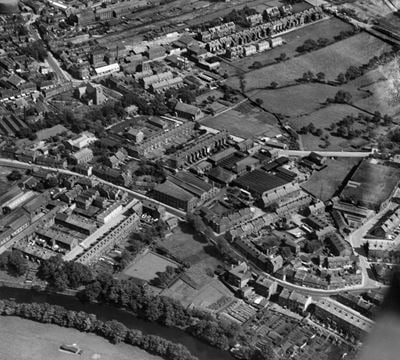
Otley
The Atlas Iron Works and town centre, Otley, 1926
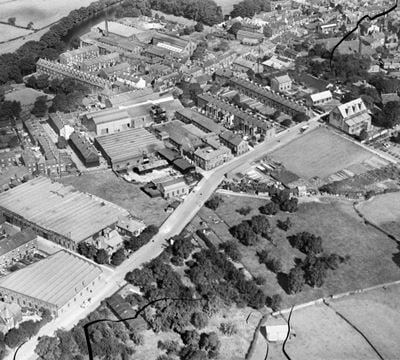
Otley
The Falcon Printing Machine Works and Atlas Iron Works, Otley, 1928
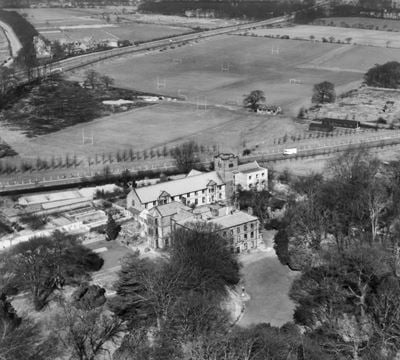
Weetwood
Weetwood Hall, Weetwood, 1948
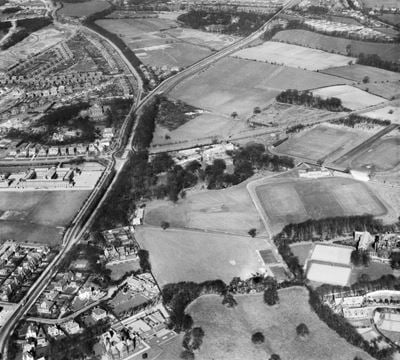
Weetwood
Weetwood Hall and the University of Leeds Athletic Grounds, Weetwood, 1948

Leeds
City Square, New Railway Station, Boar Lane and environs, Leeds, 1926
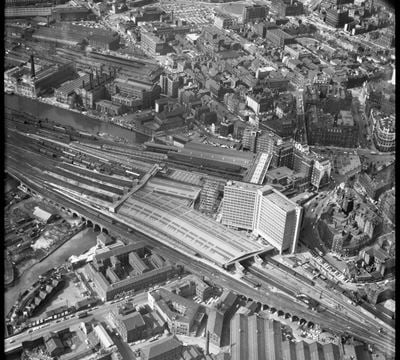
Leeds
Leeds City Station and environs, Leeds, 1964

Leeds
The Roundhouse and Half Roundhouse Warehouses alongside Holbeck Railway Junction, Leeds, 1946

Leeds
The Roundhouse and Leeds and Liverpool Canal, Leeds, 1965
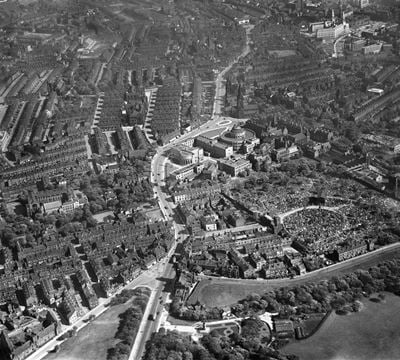
Woodhouse
The Woodhouse Cemetery and the University of Leeds buildings including the Brotherton Library, Woodhouse, 1938
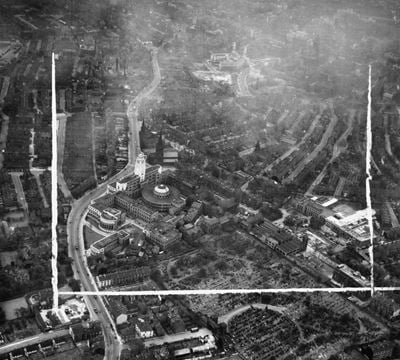
Leeds
The University of Leeds and Leeds General Cemetery, Leeds, 1953
Leeds in the Historic England Archive
The Historic England Archive cares for over 15 million images, dating from the 1850s to the present day. Discover stunning images of Leeds' past. Skip this section and go to stories about heritage
Eileen ‘Dusty’ Deste Collection
Burmantofts, Leeds, Leeds
Date created: 1966 - 1974
A view looking east along Weller Mount from Stoney Rock Lane showing houses on Scargill Close at the end of the road and Gargrave Court and Scargill...
Eric de Mare
Holbeck, Leeds, Leeds
Date created: 1945 - 1980
Copy of a wood engraving of Temple Mill taken from a Victorian book on manufacturers showing the grass roof on Marshall's one storey flax mill.
John Gay Collection: Counties
Leeds
Date created: 1955 - 1956
Looking across the landscape to a viaduct and town beyond. Possibly in West Yorkshire.
John Laing Collection
Leeds
Date created: Apr 1987
The Second Wetherby Bypass bridge across the River Wharfe, viewed from the north during placement of steel beams using a vehicle-mounted derrick crane
London, Midland and Scottish Railway Company
Kirkstall, Leeds
Date created: 30 Sep 1891
The ruins of the south transept, crossing tower and chancel of the church at Kirkstall Abbey, as seen from the south-east
Nigel Temple Collection of Postcards of Parks and Gardens
Roundhay, Leeds, Leeds
Date created: 1905 - 1910
GENERAL EXTERIOR VIEW
Eileen ‘Dusty’ Deste Collection
Burmantofts, Leeds, Leeds
Date created: 1966 - 1974
A view looking east along Weller Mount showing houses on Scargill Close at the end of the road and Gargrave Court tower block in the background
Eric de Mare
Leeds
Date created: 1945 - 1980
Interior view of Leeds University showing a common room area.
John Laing Collection
Leeds
Date created: Apr 1987
A view of the Second Wetherby Bypass bridge during construction, showing a vehicle-mounted derrick crane on the western bank of the River Wharfe...
Walter Scott
Bramham, Leeds
Date created: 1925 - 1940
An exterior view of Bramham Park showing parts of the formal gardens
Stories about heritage in your local area
Historic England publishes news, blogs, research, videos, and podcasts celebrating England's rich heritage. Discover the stories we have about Leeds. Skip this section and go to education
The Life and Work of John Smeaton, the ‘Father of Civil Engineering’
Mentions Church of St Mary
Discover the remarkable feats of engineering by British civil engineer John Smeaton.
An Introduction to Artist Henry Moore
Mentions City Art Gallery and Henry Moore Centre, Henry Moore Centre For the Study of Sculpture
From Yorkshire miner’s son to world-famous artist who revolutionised sculpture in the 20th century.
Why Exercising in Historic Green Spaces is Good for Your Mental (and Physical) Health
Mentions Roundhay Park
Explore the benefits of historic public parks and green spaces across England.
What Is the Oldest Pub or Inn in England?
Mentions Bingley Arms, Church of All Hallows
Many pubs and inns claim to be the oldest pub in England. Here are the facts.
A Brief History of Gurdwaras in England
Mentions Potternewton Park Mansion, Annex to Park Lane College
There are thought to be over 200 gurdwaras across the UK.
Lifting the Curtain: Theatre Then and Now
Mentions Grand Theatre Including Former Assembly Rooms
British theatre originated in the medieval era, with a strongly religious influence.
7 Historic Urban Parks and Gardens To Improve Your Wellbeing
Mentions Roundhay Park
Parks and green spaces are vital for our mental and physical health.
An Introduction to Quaker Meeting Houses
Mentions Rawdon Quaker Meeting House
The earliest Quaker meeting houses were distinctive for their simple, functional design; built by local craftsmen, they sit modestly in the landscape.
7 of the Best Post-war Parks, Gardens and Landscapes in England
Mentions York Gate Gardens
Here are seven of the amazing post-war parks, gardens and landscapes that exist all over England.
11 Listed Pubs with Fascinating Histories
Mentions Bingley Arms
Pull up a bar-stool and get familiar with some of England’s oldest pubs.
Where to Find Egyptian Style Architecture in England
Mentions Temple Mill
‘Egyptomania’ was the height of fashion in Regency England. Here are some of the places you can see its impact.
A Spotter’s Guide to Victorian Architecture
Mentions Numbers 1-43 and Cross Arcade
Named after the 63 year reign of Queen Victoria, the era of 1837 to 1901 inspired unprecedented social, intellectual and technological change.
Mentions Leeds
Historic England Archive staff and local historian and researcher Olivia Wyatt interviewed people connected to the, now, Leeds Carribbean and African...
Helen Daniels with Danny Friar
Historic England Archive staff and local historian and researcher Olivia Wyatt interviewed people connected to the, now, Leeds Carribbean and African Centre to discuss their backgrounds and relationships with the Leeds suburb of Chapeltown and the Centre.
Mentions Leeds
Historic England Archive staff and local historian and researcher Olivia Wyatt interviewed people connected to the, now, Leeds Carribbean and African...
Helen Daniels with Tracy Spadone
Historic England Archive staff and local historian and researcher Olivia Wyatt interviewed people connected to the, now, Leeds Carribbean and African Centre to discuss their backgrounds and relationships with the Leeds suburb of Chapeltown and the Centre.
Mentions Leeds
Historic England Archive staff and local historian and researcher Olivia Wyatt interviewed people connected to the, now, Leeds Carribbean and African...
Helen Daniels with Cara-Mia Cruise Brahm
Historic England Archive staff and local historian and researcher Olivia Wyatt interviewed people connected to the, now, Leeds Carribbean and African Centre to discuss their backgrounds and relationships with the Leeds suburb of Chapeltown and the Centre.
Mentions Leeds
Historic England Archive staff and local historian and researcher Olivia Wyatt interviewed people connected to the, now, Leeds Carribbean and African...
Helen Daniels with Leroy Wenham
Historic England Archive staff and local historian and researcher Olivia Wyatt interviewed people connected to the, now, Leeds Carribbean and African Centre to discuss their backgrounds and relationships with the Leeds suburb of Chapeltown and the Centre.
Mentions Leeds
Historic England Archive staff and local historian and researcher Olivia Wyatt interviewed people connected to the, now, Leeds Carribbean and African...
Olivia Wyatt with Arthur France MBE
Historic England Archive staff and local historian and researcher Olivia Wyatt interviewed people connected to the, now, Leeds Carribbean and African Centre to discuss their backgrounds and relationships with the Leeds suburb of Chapeltown and the Centre.
Mentions Leeds
Historic England Archive staff and local historian and researcher Olivia Wyatt interviewed people connected to the, now, Leeds Carribbean and African...
Olivia Wyatt with Angela Boddie and Vera Boddie
Historic England Archive staff and local historian and researcher Olivia Wyatt interviewed people connected to the, now, Leeds Carribbean and African Centre to discuss their backgrounds and relationships with the Leeds suburb of Chapeltown and the Centre.
Mentions Leeds
Historic England Archive staff and local historian and researcher Olivia Wyatt interviewed people connected to the, now, Leeds Carribbean and African...
Olivia Wyatt with Ken Wenham
Historic England Archive staff and local historian and researcher Olivia Wyatt interviewed people connected to the, now, Leeds Carribbean and African Centre to discuss their backgrounds and relationships with the Leeds suburb of Chapeltown and the Centre.
Mentions Leeds
Historic England Archive staff and local historian and researcher Olivia Wyatt interviewed people connected to the, now, Leeds Carribbean and African...
Helen Daniels with Cara-Mia Cruise Brahm
Historic England Archive staff and local historian and researcher Olivia Wyatt interviewed people connected to the, now, Leeds Carribbean and African Centre to discuss their backgrounds and relationships with the Leeds suburb of Chapeltown and the Centre.
Mentions Leeds
Historic England Archive staff and local historian and researcher Olivia Wyatt interviewed people connected to the, now, Leeds Carribbean and African...
Olivia Wyatt with Arthur France
Historic England Archive staff and local historian and researcher Olivia Wyatt interviewed people connected to the, now, Leeds Carribbean and African Centre to discuss their backgrounds and relationships with the Leeds suburb of Chapeltown and the Centre.
Mentions Leeds
Historic England Archive staff and local historian and researcher Olivia Wyatt interviewed people connected to the, now, Leeds Carribbean and African...
Olivia Wyatt with Ken Wenham
Historic England Archive staff and local historian and researcher Olivia Wyatt interviewed people connected to the, now, Leeds Carribbean and African Centre to discuss their backgrounds and relationships with the Leeds suburb of Chapeltown and the Centre.
Mentions Leeds
Historic England Archive staff and local historian and researcher Olivia Wyatt interviewed people connected to the, now, Leeds Carribbean and African...
Helen Daniels with Danny Friar
Historic England Archive staff and local historian and researcher Olivia Wyatt interviewed people connected to the, now, Leeds Carribbean and African Centre to discuss their backgrounds and relationships with the Leeds suburb of Chapeltown and the Centre.
Mentions Leeds
What does the future of the high street look like? In this short film, five filmmakers with autism and learning disabilities take an eclectic and...
High Streets: From Leeds to Whitley Bay
What does the future of the high street look like? In this short film, five filmmakers with autism and learning disabilities take an eclectic and colourful journey to Leeds, Ouston, Wallsend, Hexham and Whitley Bay.
Mentions Leeds
Textile mills once defined the North of England’s landscape. They were the world's workshop from Bolton to Blackburn, Bradford to Leeds.
Mills of the North
Textile mills once defined the North of England’s landscape. They were the world's workshop from Bolton to Blackburn, Bradford to Leeds. Sadly, the North’s historic mills are rapidly being lost.
50 Years of Flying for Heritage
Mentions Leeds
Learn about discoveries made in over 50 years of flying by Historic England aerial photographers and their predecessors.
Funding for Young People in Bradford to Explore and Celebrate Local history
Mentions Leeds
Historic England has announced new funding for 4 creative youth-led projects in Bradford in collaboration with Bradford 2025 UK City of Culture.
Leeds Caribbean and African Communities Celebrated in New Historic England Photographic Collection
Mentions Leeds
Historic England has added a new photographic collection celebrating Leeds Caribbean and African communities to its national Archive.
New Funding to Celebrate Rural and Coastal Working-Class Heritage
Mentions Leeds
Historic England is funding new projects to explore untold stories and celebrate the people and places at the heart of our history.
Historic England Photography Project Launches in Leeds
Mentions Leeds
A new photography project aiming to capture Chapeltown’s African and Caribbean community has been launched by Historic England.
New Funding to Uncover and Celebrate Working Class Heritage
Mentions Leeds
Historic England's Everyday Heritage Grant programme is funding 56 new projects across the nation, telling the stories of working class heritage.
Picturing High Streets: Over 200 Images Taken by the Public Enter Historic England Archive
Mentions Corn Exchange, Leeds
Documenting a year in the life of the English high street, images taken by the public as part of 'Picturing High Streets' can be viewed online.
Leeds West Indian Centre Celebrates 40th Anniversary with Historic England
Mentions Leeds
Leeds West Indian Centre's 40th anniversary celebrations will include an exhibition featuring images from the venue's opening event in 1983.
Historic England Highlights Fascinating Heritage Sites Listed in 2022
Mentions Roman Catholic Church of St Edward, King and Confessor
As 2022 draws to a close, Historic England highlights gems added to the National Heritage List for England (NHLE) over the last 12 months.
Black British History Highlighted by New Listings and Amendments on the National Heritage List for England
Mentions Grave memorial to Susannah Darby and William Darby (also known as Pablo Fanque), Leeds
Two new listings and three amendments to existing listings announced to mark Black History Month 2022.
11 Remarkable Historic Pubs Given Protection
Mentions Whitelock's Ale House, Leeds
A project to save rare historic pub interiors sees 11 remarkable pubs being newly listed, having their listing upgraded or list entry updated.
Historic England Reveals its Heritage at Risk Register 2021
Mentions First Leeds Cloth Hall, Leeds
Historic England publishes its annual Heritage at Risk Register, the yearly health-check of England’s most valued historic places.
Leeds' social history through photos
Over 10,000 images from the Historic England Archive have been specially selected and re-captioned for teachers, students, and anyone who wants to learn more about their local area. Skip this section and go to grant-aided places
Top Rank Bingo Hall, Leeds, West Yorkshire
Period: 1920s (1920 - 1929)
Formerly known as the Majestic Cinema. It was built in 1921 by Pascal J Steinlet in a Classical 'Beaux Arts' style.
Top Rank Bingo Hall, Leeds, West Yorkshire
Temple Mill, Leeds, West Yorkshire
Period: Victorian (1837 - 1901)
Temple Mill was built as a Flax spinning mill in 1838-43 by Ignatious Bonomi the younger of Durham, for John Marshall and Company.
Temple Mill, Leeds, West Yorkshire
Statue of Robert Peel, Leeds, West Yorkshire
Period: Victorian (1837 - 1901)
Robert Peel founded the Police Force when Home Secretary in 1822-27 and 1828-30; in 1829 he introduced Roman Catholic emancipation and was Prime...
Statue of Robert Peel, Leeds, West Yorkshire
Statue of HR Marsden, Leeds, West Yorkshire
Period: Victorian (1837 - 1901)
Henry Rowland Marsden was born in 1823, the son of a soldier; he worked at Marshall's flax mill and became an apprentice tool-maker to William Wesley.
Statue of HR Marsden, Leeds, West Yorkshire
Station House, Station Road, Horsforth, West Yorkshire
Period: Georgian (1714 - 1836)
This farmhouse with its attached barn and cottage, was later used as the station master's house. The station is just behind the house.
Station House, Station Road, Horsforth, West Yorkshire
St James' Hospital, block north-west of the chapel, Leeds, West Yorkshire
Period: Victorian (1837 - 1901)
This hospital block was once a Poor Law infirmary, built in 1872-4 with late 20th century alterations.
St James' Hospital, block north-west of the chapel, Leeds, West Yorkshire
St Anne's Roman Catholic Cathedral, Leeds, West Yorkshire
Period: Edwardian (1902 - 1913)
St Anne's Roman Catholic Cathedral was built in 1902-4 by JH Eastwood and SK Greenslade, using the remains of an earlier church.
St Anne's Roman Catholic Cathedral, Leeds, West Yorkshire
Roundhay Park, Leeds, West Yorkshire
Period: Edwardian (1902 - 1913)
View across the park looking towards bandstand and mansion.
Visit grant-aided places near you
These places and buildings have been helped by Historic England's financial grants. Find local heritage in your neighbourhood that you never knew existed! Please note that opening times may vary. Skip this section and go to related locations
First White Cloth Hall, 98-100 Kirkgate, Leeds
First White Cloth Hall is a repurposed Grade II*-listed textiles trading hall, featuring a glazed atrium set over two floors.
Discover more
Ready for more local stories? Take a look at these other places nearby

West Yorkshire
Ceremonial County

Wakefield
Local Authority District

Bradford
Local Authority District